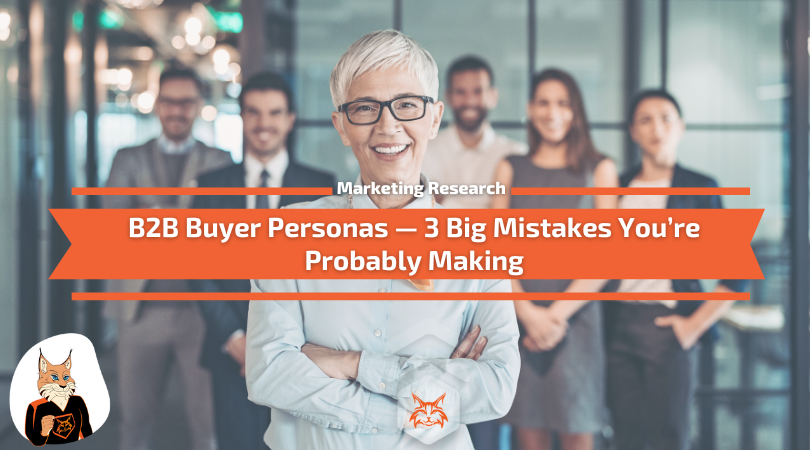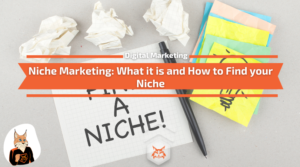B2B buyer personas are one of the most important things your marketing department is likely getting wrong.
According to an article from Aberdeen, she was astounded when persona expert Adele Revella contacted some of her clients, hoping to put together case studies from her work. It seems her customers had appreciated her insights, but they couldn’t speak to how the personas had improved performance — because they hadn’t used them. Her clients didn’t know what to do with their B2B buyer personas once they had them.
For others, the process goes awry much earlier. According to B2B marketing strategist Ardath Albee, many people start by collecting the wrong information.
Done right, B2B buyer personas help your company connect better with its customers. But too many companies fall prey to costly mistakes. Let’s see how you can ensure your buyer personas become the incredible resource they are meant to be.
The Importance of B2B Buyer Personas
B2B buyer personas deepen your understanding of your audience.
Creating and using personas can have a powerful financial impact on your company. A study by marketing data company Cintell found a correlation between companies that use personas and the likelihood of meeting goals for leads and revenue. They found that “companies that exceed lead and revenue goals are 2.2 times more likely to have and document personas than companies that miss these targets.”
So, what goes wrong when it comes to B2B buyer personas?
Mistake #1: Collecting the Wrong Information
Albee reports that she noticed that B2B marketers who had created buyer personas kept them in the closet. When she took a look at the personas, she understood why. They contained the wrong information.
Albee noted that when the information in a B2B persona is simplified and too high level, it does nothing to help you differentiate your company and connect better with target audiences.
The information you need on a B2B buyer will differ greatly from that on a B2C customer. This is because most B2B purchases are inherently different from B2C purchases.
According to Dun & Bradstreet, B2B purchases are typically for a much higher purchase amount than B2C. The purchase can affect an entire organization or department, so buying involves more people and takes longer. As many as 5-12 people can play a role in the B2B buying, which may span months or even years.
A B2B purchase is also more likely to be driven by relationships with suppliers and logical evaluation than a B2C purchase, which tends to be more emotionally driven.
A B2B persona needs the information you can act on
A B2B buyer persona should include information about the targeted person’s role and attitudes during the purchase process. To produce actionable insights, you need to understand what influences their decision-making.
- How do they hope to use or interact with your product during their work, and how frequently is their use case?
- How do they feel about your products or services compared to your competitors’?
- What role do they play in the buying process?
- What resources do they consult while considering the purchase?
- When and how do they prefer to interact with vendors?
Who should be involved in creating your personas?
Collaborate with any team at your company that has contact with your customers. This means sales, customer service, and product teams at many organizations. Each team will add a slightly different perspective.
Getting your personas right can feel daunting. A buyer persona cheat sheet can help. Check out these examples of B2B buyer personas.
Mistake #2: Failing to Use Your Personas
Revella says buyer personas should lead to action and generate business for your company. But she discovered that many B2B marketers fail to use their buyer personas once they have created them.
How should you use them, exactly? The Cintell study has the answer. The research shows that companies exceeding their revenue goals use buyer personas in these three ways.
1. Adapt your marketing messaging
Well-crafted B2B buyer personas hold information that will help you segment customers. When you segment your customers into groups represented by personas, you can tailor words and themes to their needs and attitudes in your messaging.
Consider creating segments according to their role in the purchase decision. Here’s what that might look like.
Thrive, an executive recruiting software company shows what a recruiting firm goes through to get buy-in from different groups internally when adopting a new applicant tracking system. The firm must involve end users, get buy-in from upper management, enlist the marketing team, and possibly engage HR to plan for training. In addition, an IT team will weigh in with any software purchase.
Each of these groups has its concerns and wants. You can segment according to the end user, marketing, IT, and HR buyer personas so that you can speak directly to them in your marketing content.
According to Revella, this personalization includes what NOT to say as much as what to say. When you learn that CIOs don’t care to hear about branding benefits, for example, you should make sure not to talk about that in your messaging.
2. Plan your campaigns
Good target persona B2B research surfaces information that points the way to the most effective channels to reach customers at different points in the buyer journey. You can see which trade publications carry weight with different target personas, which buyers conduct research independently, and which will welcome calls from a sales rep, for example.
You might discover that end-users in an organization are the first to recognize the need for your product, and when they approach their manager, they come with a shortlist in hand. Their research may start with Google searches, progress to downloading a few white papers to study the problem and solutions, and then start vetting providers by reading customer reviews.
This knowledge lets you know which content will be most impactful at which stage of the journey, so you can determine where and how to advertise your marketing assets. In this example, you can see that SEO will be an important vehicle to reach end users who are starting to research the problem, while retargeted advertising with your white papers can reach them as they become better informed.
3. Train your salespeople
Personas also make an excellent orientation and training tool for departments outside of marketing.
Personas are not new to the sales arena, however. For years, sales departments have identified six different types of buyers. These typically refer to the style of the individual. Are they analytical? Skeptical? Are they more decisive or collaborative? Are relationships their main driver?
However, sales departments are now catching onto the power of personal profile-style B2B buyer personas. Jesse Davis at ringDNA, a sales AI platform, says that training sale reps to tailor-fit their messaging to specific buyer personas can lead to “a powerful advantage.” He notes that these marketing personas can help new B2B sales reps onboard faster, reducing the overwhelming for someone new to the job. In addition, they can help build cold-calling lists to make the practice more effective.
Collaborating with departments outside of marketing is important for creating and using your personas and keeping them up to date.
Mistake #3: Letting Your Personas Become Stale
Attitudes, buying processes, and competing offerings will change over time. Revisiting your B2B buyer personas allows your company to stay plugged into what’s happening in your industry.
This market research appears to be well worth the effort. According to Cintell’s study, companies that exceed their lead and revenue goals are 7.4 times more likely to have updated their personas in the last six months than those that missed their goals.
Companies that exceed their lead and revenue goals are 7.4 times more likely to have updated their personas in the last six months.Click to tweetKeep it fresh
According to the study, high-performing teams stay abreast of changes in the world of their buyers. Check out new technologies and regulations, for example. Once you have the initial personas prepared, the following rounds of research will be simpler since you’ll already have a structure you can follow.
Consider saving your B2B digital personas research in a centralized place to provide a single source of truth your organization can update and rely on across different teams.
We Can Help You Connect with Your B2B Buyer Personas
B2B buying decisions involve several people, each with their own “language” and concerns. B2B marketers face challenges in crafting communications that appeal to each segment. How can you get to know the person’s “language” without domain expertise?
We can help you learn the content and wording that appeal to each of your segments when creating a persona for B2B marketing. Alexa can help you answer these questions and more:
- What sites, topics, and keywords attract my personas?
- What keywords do they use when they’re ready to buy?
- Which sites lead in search results for topics my personas care about?




